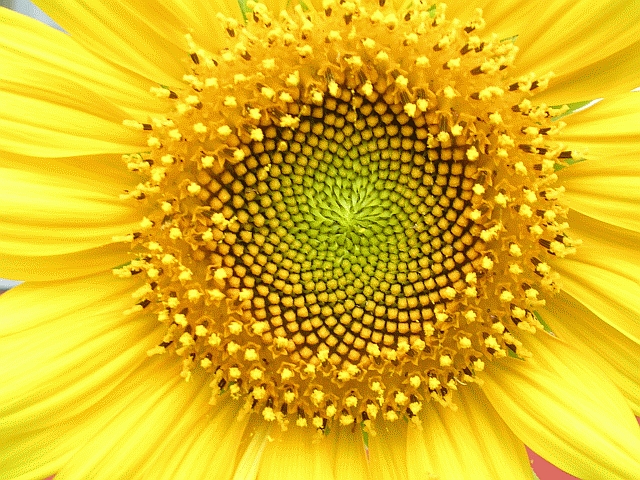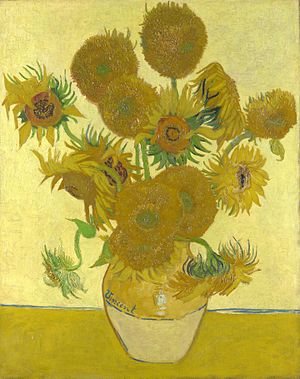Hi Everybody!
Please come in for a Nature Break!
It has been a busy week and the weekend is arriving just on time! We are walking out to the garden tonight to see the sunflower my squirrel planted. The squirrels and the birds seem to plant their own gardens. They grow sunflowers and corn in my flower beds! (Far away from the seed stations!)
Your photostudy tonight is of Casper's Sunflower! These images are all of the same flower at different stages and different times of day. Next you will see a few facts, and topping it off with some videos!
This is Your Point to Ponder as you scroll through the Garden: Why is the Sunflower one of the most important flowers of Earth? Enjoy!
(see you back on Monday)
Sunflower Fields! Just Push Play>
Just Push Play>
Sunflower
From Wikipedia, the free encyclopedia
 | |
| Scientific classification | |
|---|---|
| Kingdom: | Plantae |
| Division: | Angiospermae |
| Phylum: | Magnoliophyta |
| Subdivision: | Eudicots |
| Class: | Asterids |
| Order: | Asterales |
| Family: | Asteraceae |
| Subfamily: | Helianthoideae |
| Tribe: | Heliantheae |
| Genus: | Helianthus |
| Species: | H. annuus |
Description
What is usually called the "flower" on a mature sunflower is actually a "flower head" (also known as a "composite flower") of numerous florets, (small flowers) crowded together. The outer petal-bearing florets are the sterile ray florets and can be yellow, red, orange, or other colors. The florets inside the circular head are called disc florets, which mature into seeds.
The flower petals within the sunflower's cluster are usually in a a spiral pattern. Generally, each floret is oriented toward the next by approximately the golden angle, 137.5°, producing a pattern of interconnecting spirals, where the number of left spirals and the number of right spirals are successive Fibonacci numbers. Typically, there are 34 spirals in one direction and 55 in the other; on a very large sunflower there could be 89 in one direction and 144 in the other.[1][2][3] This pattern produces the most efficient packing of seeds within the flower head.[4][5][6]
Sunflowers most commonly grow to heights between 1.5 and 3.5 m (5–12 ft). Scientific literature[who?] reports that a 12 m (40 ft), traditional, single-head, sunflower plant was grown in Padua in 1567. The same seed lot grew almost 8 m (26 ft) at other times and places, including Madrid.[citation needed] During the 20th century, heights of over 8 m have been achieved in both the Netherlands andOntario, Canada.

http://en.wikipedia.org/wiki/File:Helianthus_whorl.jpg
History
The evidence thus far is that the sunflower was first domesticated in Mesoamerica, present day Mexico, by at least 2600 BC.[11] It may have been domesticated a second time in the middle Mississippi Valley, or been introduced there from Mexico at an early date, as maizewas. The earliest known examples of a fully domesticated sunflower north of Mexico have been found in Tennessee, and date to around 2300 BC[citation needed]. Many indigenous American peoples used the sunflower as the symbol of their solar deity, including the Aztecsand the Otomi of Mexico and the Incas in South America. Francisco Pizarro was the first European to encounter the sunflower in Tahuantinsuyo, Peru. Gold images of the flower, as well as seeds, were taken back to Spain early in the 16th century. Some researchers argue that the Spaniards tried to suppress cultivation of the sunflower because of its association with solar religion and warfare.[12]
During the 18th century, the use of sunflower oil became very popular in Europe, particularly with members of the Russian Orthodox Church, because sunflower oil was one of the few oils that was not prohibited during Lent, according to some fasting traditions.
http://en.wikipedia.org/wiki/Sunflowerhttp://www.ehow.com/facts_5828379_can-grown-next-vegetable-garden_.html
Can Sunflowers Be Grown Next to a Vegetable Garden?
Features
- Sunflowers grow tall or small depending on the variety. A wall of tall sunflowers in summer provides partial shade for sun-sensitive vegetables. Sunflowers attract bees and other pollinators to nearby vegetable blossoms.
Related Vegetables
- Sunflower-related plants are grown in vegetable gardens. The sunflower family, or Asteraceae, includes endive, chicory, lettuce and Jerusalem artichoke.
Related Flowers
- Flowers such as marigolds, zinnias, chrysanthemums and calendulas are related to sunflowers and can be grown next to vegetable gardens.
Pest Control
- The University of Illinois Extension recommends planting sunflowers in your vegetable garden. These plants attract beneficial insects and predators such as birds that help control garden pests.
Uses
- The sunflower offers edible seeds and tubers. It is useful as a cut flower.
Sunflowers in the Garden. Just Push Play>
Sunflowers for Fuel. Just Push Play>
http://en.wikipedia.org/wiki/Environmental_impact_of_biodiesel
Environmental impact of biodiesel
From Wikipedia, the free encyclopedia
Greenhouse gas emissions
An often mentioned incentive for using biodiesel is its capacity to lowergreenhouse gas emissions compared to those of fossil fuels. If this is true or not depends on many factors. Especially the effects from land use change have potential to cause even more emissions than what would be caused by using fossil fuels alone.[3]
Carbon dioxide is one of the major greenhouse gases. Although the burning of biodiesel produces carbon dioxide emissions similar to those from ordinary fossil fuels, the plant feedstock used in the production absorbs carbon dioxide from the atmosphere when it grows. Plants absorb carbon dioxide through a process known asphotosynthesis which allows it to store energy from sunlight in the form of sugars and starches. After the biomass is converted into biodiesel and burnt as fuel the energy and carbon is released again. Some of that energy can be used to power an engine while the carbon dioxide is released back into the atmosphere.
When considering the total amount of greenhouse gas emissions it is therefore important to consider the whole production process and what indirect effects such production might cause. The effect on carbon dioxide emissions is highly dependent on production methods and the type of feedstock used. Calculating the carbon intensity of biofuels is a complex and inexact process, and is highly dependent on the assumptions made in the calculation. A calculation usually includes:
- Emissions from growing the feedstock (e.g. Petrochemicals used in fertilizers)
- Emissions from transporting the feedstock to the factory
- Emissions from processing the feedstock into biodiesel
Other factors can be very significant but are sometimes not considered. These include:
- Emissions from the change in land use of the area where the fuel feedstock is grown.
- Emissions from transportation of the biodiesel from the factory to its point of use
- The efficiency of the biodiesel compared with standard diesel
- The amount of Carbon Dioxide produced at the tail pipe. (Biodiesel can produce 4.7% more)
- The benefits due to the production of useful by-products, such as cattle feed or glycerine
If land use change is not considered and assuming today's production methods, biodiesel from rapeseed and sunflower oil produce 45%-65% lower greenhouse gas emissions than petrodiesel.[4][5][6][7] However, there is ongoing research to improve the efficiency of the production process.[4][6] Biodiesel produced from used cooking oil or other waste fat could reduce CO2 emissions by as much as 85%.[1] As long as the feedstock is grown on existing cropland, land use change has little or no effect on greenhouse gas emissions. However, there is concern that increased feedstock production directly affects the rate of deforestation. Such clearcutting cause carbon stored in the forest, soil and peat layers to be released. The amount of greenhouse gas emissions from deforestation is so large that the benefits from lower emissions (caused by biodiesel use alone) would be negligible for hundreds of years.[3][1] Biofuel produced from feedstock such as palm oil could therefore cause much higher carbon dioxide emissions than some types of fossil fuels.
The Harvest. Just Push Play>
Remember to feed the birds the sunflower seeds!!!
Sunflower Sprouts. Just Push Play>
http://www.motherearthnews.com/Organic-Gardening/1979-11-01/Sunflower-Sprouts.aspx
SUNFLOWER SPROUTS
Growing delectable snacks or salad greens on your windowsill.
Read more: http://www.motherearthnews.com/Organic-Gardening/1979-11-01/Sunflower-Sprouts.aspx#ixzz1vwFNySJ8 by BONNIE MANDOE
As far as my tastebuds are concerned, sprouted sunflowers are about the most delicious germinated seeds available ... and I've tried nearly all of the common sprout varieties including alfalfa, lentil, radish, fenugreek, garbanzo, wheat, soy, mung, azuka, red clover, cress, and chia.
Also—while many of us do know that sunflower seeds are nutritionally potent little packages—few people realize that the tasty kernels are almost 25% protein ... contain vitamins A, D, E, and the B complex ... provide incredible amounts of potassium ... and are high in calcium, magnesium, and iron. And, of course—since germination activates a plant's stored energy—the sprouts have fewer calories, yet more of all these vitamins and minerals than do the dry seeds!
However, unlike most sprouts (which can be grown in a simple screen-topped jar), baby sunflowers are germinated upon soil. An old drawer—with small holes drilled in the bottom for drainage—makes an ideal sprout box ... or, if you prefer, you can simply construct a flat out of scrap lumber. (In either case, the depth of the growing container need not exceed three inches.) Then, cover the drainage holes with pebbles ... fill the box—to a depth of about two inches—with garden soil... and place it in a sunny location (a heated greenhouse would, of course, serve this purpose perfectly, but a good "southerly" window can provide all the light you'll need). Next—in order to have 2-1/2 square feet of these crisp and tender morsels ready for the table in seven to ten days—follow this procedure:
[1] Soak 4 cups of unhulled sunflower seeds for 8 to 12 hours ... scatter them one layer thick ... and press 'em down (firmly) on the soil with your hands.
[2] Sprinkle the box with water and cover it with newspaper.
[3] Water the seeds— through the newspaper—once a day until the growing sprouts start pushing the paper up ... which should take two to four days, depending on the temperature. Then remove the newsprint and continue to give the seedlings a drink daily, picking the seed hulls off the leaves only after the small plants begin to stand up.
[4] Reap your harvest with scissors when the first two leaves open ... rinse ... shake dry... and—if you don't eat 'em all in one sitting—store the excess in the refrigerator.
[5] Voila! You're ready for some delicious, nutritious, "garden"-fresh treats.
Read more: http://www.motherearthnews.com/Organic-Gardening/1979-11-01/Sunflower-Sprouts.aspx#ixzz1vwFEMbNi ...this is brendasue signing off from Rainbow Creek
See You next time!
Just Push Play>
Of course, one more Great Performance:
Just Push Play>
http://en.wikipedia.org/wiki/Sunflowers_(series_of_paintings)
| Original title, in French: Tournesols | |
 | |
| Artist | Vincent van Gogh |
|---|---|
| Year | 1888 |
| Type | Oil on canvas |
| Dimensions | 92.1 cm × 73 cm (36.2 in × 28.7 in) |
| Location | National Gallery, London |
O+O





.JPG)

















No comments:
Post a Comment
Hi Everybody! Please say hello and follow so I know you are here! Due to the inconsideration of people trying to put commercials on my blog comment area, I have restricted use of anonymous posts. Sorry that some hurt all.
My public email is katescabin@gmail.com No spammers or trolls